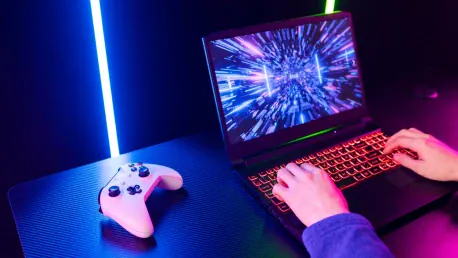In an intriguing development within the tech industry, Nvidia is reportedly developing its first Arm-based APU intended for use in gaming laptops. This new technology aims to offer performance comparable to an RTX 4070 mobile GPU while operating at a power target of up to 80W. As tech enthusiasts eagerly await more details, Nvidia’s unique approach promises significant gaming performance alongside low power consumption. According to tech YouTuber Moore’s Law is Dead (MLID), sources within Nvidia and its partners suggest that Alienware, a subsidiary of Dell, may integrate this cutting-edge technology in their upcoming gaming laptops, potentially hitting the market by late 2025 or 2026.
Nvidia’s Strategic Pivot to Arm Architecture
Arm Architecture Shaping Nvidia’s Future
Nvidia’s pivot to Arm architecture marks a significant strategic decision that aligns with the potential end of Microsoft’s exclusive Qualcomm-Arm deal. This change indicates that Nvidia is likely to collaborate with MediaTek for the production of these new APUs. This shift not only promises a more robust ecosystem for Nvidia’s advancements in AI and gaming technologies but also heralds significant improvements in Windows on Arm. Nvidia has been a prominent player in the AI field, and the inclusion of a powerful neural processing unit (NPU) for AI tasks in the new APU highlights Nvidia’s broader strategy to integrate AI capabilities into its product lineup.
In addition to its efforts in enhancing AI functionalities, Nvidia’s move towards Arm architecture opens doors to developing high-performance gaming laptops that consume less power. By focusing on the Arm architecture, Nvidia aims to provide impressive gaming experiences without the need for high power intake often associated with traditional GPU setups. The tech giant’s collaboration with MediaTek is expected to foster innovations that further capitalize on Nvidia’s AI strengths, promising futuristic advancements in both gaming and AI-integrated laptop designs.
Improving Windows on Arm for Gaming
One of the significant implications of this development is the anticipated improvement and optimization of the Windows on Arm operating system. Insider builds of Windows are already adding support for AVX and AVX2 instructions, which is a crucial step towards making more games compatible with Windows on Arm platforms. Nvidia’s new APU promises to drive this transition, potentially leading to a broader adoption of Arm-based Windows gaming systems. This initiative positions Nvidia to provide a seamless gaming experience on Arm-based platforms, bridging the gap between mobile and high-end discrete GPU performance.
As Nvidia seeks to optimize gaming performance on Windows on Arm, the company’s efforts are likely to result in an ecosystem that supports a wide array of games and software. This move is significant as it not only aims to enhance gaming experiences but also supports the overall transition towards more energy-efficient computing solutions. By improving Windows on Arm’s compatibility, Nvidia is addressing a key challenge within the tech community, emphasizing the potential for broader application and user adoption of Arm-based solutions in gaming and beyond.
Competing with AMD’s Strix Halo APUs
High Stakes in Mobile Gaming Performance
Nvidia’s foray into Arm-based APUs directly positions it against AMD’s upcoming Strix Halo APUs, which are set to be the most powerful mobile chips from AMD. These potent chips will feature substantial RDNA 3.5 compute units and various configurations, boasting up to 40 CUs and 16 CPU cores. Nvidia aims to match or surpass these capabilities with its own APU, equipped with advanced features such as an integrated NPU for AI tasks. This competition promises to bring groundbreaking gaming experiences to mobile platforms, with both Nvidia and AMD vying for supremacy in the high-performance mobile gaming sector.
The rivalry between Nvidia and AMD is expected to spur rapid advancements and innovations in mobile gaming hardware. Gamers can anticipate significant enhancements in game performance, graphics quality, and overall user experience. Nvidia’s focus on creating an APU that delivers high-end gaming performance while maintaining low power consumption could shift the dynamics of the gaming laptop market, attracting a broad audience from casual gamers to professional eSports athletes.
The Impact on Gaming Brands like Alienware
Major gaming brands such as Alienware, under Dell, have shown interest in integrating Nvidia’s new APU technology into their gaming laptops. This collaboration is set to elevate the gaming experience to new heights, with devices offering unprecedented performance levels in portable form factors. The partnership between Nvidia and Alienware underscores the potential for creating gaming laptops that rival the power of traditional desktop setups, all while maintaining a sleek and portable design. Gamers can look forward to Alienware’s pioneering efforts in adopting Nvidia’s cutting-edge technology, promising a new era of gaming laptops.
Alienware’s potential integration of Nvidia’s APU technology also highlights the growing trend of major brands investing in innovative hardware solutions to stay ahead in the competitive gaming market. The gaming community’s expectations are undoubtedly high, as Nvidia and Alienware are known for pushing the boundaries of performance and design. As we approach the anticipated release window of 2025 or 2026, the industry watches closely for how these advancements will shape the future of gaming laptops.
Bridging the Gap Between Mobile and Desktop Performance
Developing New Standards for Gaming Laptops
Nvidia’s first Arm-based APU, intended to rival AMD’s Strix Halo chips, signifies a move towards bridging the gap between mobile and high-end discrete GPU performance. This development is expected to herald a new era of gaming laptops, providing top-tier gaming experiences in portable devices. Nvidia’s innovative approach aims to offer high-performance gaming without the traditional constraints associated with mobile platforms, pushing the boundaries of what gaming laptops can achieve.
By developing new standards for gaming laptops, Nvidia paves the way for an exciting future where gamers can enjoy desktop-level performance on the go. This shift could redefine the gaming industry standard, as more manufacturers look to adopt similar technologies to stay competitive. Nvidia’s efforts to innovate within the APU market promise to bring substantial benefits to gamers, particularly those seeking high-performance gaming solutions in portable devices.
Envisioning the Future of Arm-based Gaming Systems
In a fascinating development within the tech sector, Nvidia is reportedly working on its first Arm-based APU designed for gaming laptops. This innovative technology aims to deliver performance on par with an RTX 4070 mobile GPU while maintaining a power target of up to 80W. As tech aficionados eagerly await further information, Nvidia’s pioneering approach promises substantial gaming performance combined with lower power consumption. According to tech YouTuber Moore’s Law is Dead (MLID), sources within Nvidia and its partners reveal that Alienware, a branch of Dell, might incorporate this state-of-the-art technology into their upcoming gaming laptops. These advanced devices are expected to hit the market by late 2025 or 2026, potentially setting a new standard in the gaming laptop industry. This potential integration signifies a major step forward, aligning with the industry’s trend towards more efficient and powerful gaming solutions, further cementing Nvidia’s leading position in the tech world.









